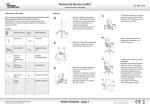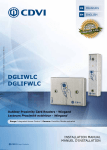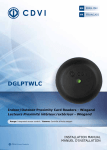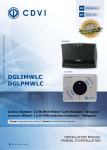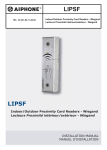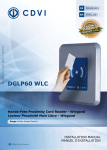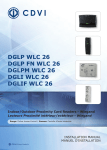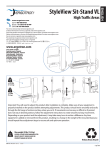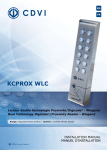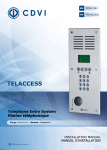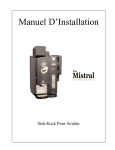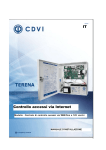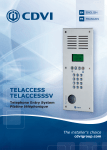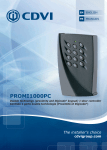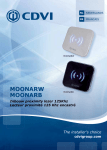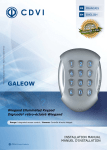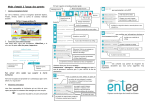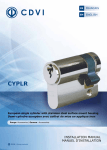Download DGLPWLC and DGLIWLC
Transcript
EN ENGLISH FR FRANCAIS DGLPWLC DGLPFNWLC DGLIWLC DGLIFWLC Indoor/Outdoor Proximity Card Readers - Wiegand Lecteurs Proximité intérieur/extérieur - Wiegand Range: Integrated Access Control / Gamme: Contrôle d’Accès centralisé INSTALLATION MANUAL MANUEL D’INSTALLATION Group Products INSTALLATION MANUAL EN DGLPWLC - DGLPFNWLC - DGLIWLC - DGLIFWLC Proximity Card Readers - Wiegand Output 1] PRODUCTS OVERVIEW Wiegand 26,30 or 44 bits. Direct connection to the controller or with the door controller (INTBUSW). PCB sealed in epoxy. Audible and visual feedback. Available in version: - Polycarbonate standard “VO” (DGLPWLC). - Stainless steel (DGLIWLC). DGLPWLC (L x W x D): 103 x 81 x 23mm. DGLPFNWLC (L x W x D): 139 x 41 x 23mm. Technology: 125 kHz*. Multi card protocol reader. Input voltage: 12V dc. Consumption: 100mA. DGLIWLC DGLPFNWLC DGLPWLC Certification FCC CFR 47 part 15 compliance CE Certification WEEE DGLIFWLC E TANC RESIS HIGH ANDALISM V TO IP53 -25°C to +70°C 2] RECOMMANDATIONS Important To protect the device from back - emf do not forget to mount the varistor on the lock in parallel. Optional Single gang box mounting plate for the DGLPFNWLC reader (Ref: MPLATE). Recommended cables 4 twisted pairs 0.6 MM. Environment When in a humid area or close to a sea shore, we recommend applying a varnish on the terminals to avoid oxidation. Suggested power supplies ARD12 & BS60 3] MOUNTING KIT ® ® Varistor Diax spanner Diax screw stainless steel Brass anchor DGLIWLC 1 1 2 2 - DGLPWLC 1 - - - DGLIFWLC 1 1 2 DGLPFNWLC 1 - - 2 cdvi.com cdvigroup.com Plastic anchor Wood screw 3 x 40 mm - - - 2 2 2 2 2 - - - - - 2 2 2 2 Right cover Left cover * Complies with European R&TTE directive 99/5/EC and harmonised standards: ETS 301 489 and ETS 300-330-1-Ed 2001. Complies with applicable EMC standards: EN 50133, EN 50130-4. INSTALLATION MANUAL EN DGLPWLC - DGLPFNWLC - DGLIWLC - DGLIFWLC Proximity Card Readers - Wiegand Output 4] WIRING DIAGRAM : DGLPWLC, DGLIWLC, DGLPFNWLC et DGLIFWLC DGLPFNWLC and DGLIFWLC Wiring Red Input voltage 12VDC Black 0V Blue Clock DIPSWITCH 1 & 2 POSITIONNING OFF/OFF 26 bits Green Data 0 White Data 1 Brown Buzzer Yellow Green LED Orange Red LED 1 2 3 4 ON/OFF 30 bits ON OFF/ON 44 bits ON/ON Non allocated DIPSWITCH 3 POSITIONNING The buzzer and the LED’s can be controlled by the reader or by an external device. ON Centaur Mode In standard, when a card or a tag is placed within the reader the orange LED is activated and the buzzer emit a tone. The Centaur controller can manage the LED and the buzzer to program other operations. OFF CDVI Mode The controller or the audio entry system can manage the LED and the buzzer to program other operations. DIPSWITCH 4 POSITIONNING Pulls up 12 V or 5V Open collector outputs: OFF Pull up 5V Terminal (8 pins) + Input voltage 12VDC - 0V H Clock D0 Data 0 D1 Data 1 B Buzzer V Green LED R Red LED DGLPWLC and DGLIWLC ON Pull up 12V Select the output voltage according to the installation. cdvi.com cdvigroup.com 3 INSTALLATION MANUAL EN DGLPWLC - DGLPFNWLC - DGLIWLC - DGLIFWLC Proximity Card Readers - Wiegand Output 6] OUTPUT FORMATS 26, 30 ET 44 BITS WIEGAND Chronograms 1 logic 0 logic \DATA1 \CLOCK \DATA0 50 µs 2ms 50 µs 2ms Open collector output with internal pulls up 1K at +5V or +12V according the ST4 position. 26-bit Wiegand Output Structure and description of the code : DGLPWLC - DGLPFNWLC - DGLIWLC - DGLIFWLC > Place the ST5 jumper on 1 Format 26-bit hexadecimal. The output format is 26-bit Wiegand (Signals: DATA1, DATA0 and CLOCK) The frame is made of 26-bit and built as follow: 1- First parity: 1-bit – even parity for the first 12-bit Code of the badge: 6 half byte represent the last 6 digit of the code (4bit = 1 digit of a code) Each byte is transferred from bit 7 to bit 0. 2 - Second parity: 1-bit – odd parity for the last 12-bit Bit 1 Bit 2 to bit 25 Bit 26 Even Parity on bit 2 to bit 13 Data (24 bit) Odd Parity on bit 14… bit 25 Example: code of the badge is 0100166A37. 1 0001 0110 0110 1010 0011 0111 0 Parity 1 1 6 6 A 3 7 Parity 2 The code transmitted is in hexadecimal format 166A37 Parity 1: 0 if the number of 1 in bit 2 to bit 13 is even 1 if the number of 1 in bit 2 to bit 13 is odd Parity 2: 0 if the number of 1 in bit 14 to bit 25 is odd 1 if the number of 1 in bit 14 to bit 25 is even 4 cdvi.com cdvigroup.com INSTALLATION MANUAL EN DGLPWLC - DGLPFNWLC - DGLIWLC - DGLIFWLC Proximity Card Readers - Wiegand Output 30-bit Wiegand Output Structure and description of the code : DGLPWLC - DGLPFNWLC - DGLIWLC - DGLIFWLC > Place the ST5 jumper on 2 Signals output in open collectors with pull up in 30-bit hexadecimal format. The output format from the proximity reader is 30-bit wiegand (Signal: DATA1, DATA0 and CLOCK) and is structured as follow: 1- First parity : 1 bit – even parity for the first 14-bit Code : A code is formed from 7 half byte. Each byte is transferred from bit 7 to bit 0. 2 - Second parity: 1 bit – odd parity for the last 14-bit Bit 1 Bit 2 à bit 29 Bit 30 Even Parity from bit 2 to bit 15 Data (28-bit) Odd Parity from bit 16 to bit 29 Example A : Temic card decimal code: 689905 (in hexadecimal: A86F1). 1 0000 0000 1010 0110 0110 1111 0001 0 Parity 1 0 0 A 8 6 F 1 Parity 2 The code number of the card is 00A86F1 in hexadecimal Example B : EM badge hexadecimal code: 0100166A37 1 0000 0000 0001 0001 0110 1011 0110 1 Parity 1 0 0 6 6 A 3 7 Parity 2 The code transmitted is in hexadecimal format 0166A37 Parity 1: Parity 2: 0 1 0 1 if if if if the the the the number number number number of of of of 1 1 1 1 in in in in bit bit bit bit 2 to bit 15 is even 2 to bit 15 is odd 16 to bit 29 is odd 16 to bit 29 is even 44- bit Wiegand Format Output DGLPWLC - DGLPFNWLC - DGLIWLC - DGLIFWLC > Place the ST5 jumper on 3 44-bit hexadecimal format. The output format from the proximity reader is 44-bit (Signal: DATA1, DATA0 and CLOCK) and is structured as follow: 1 - Data: 10 digit code number hexadecimal MSByte first . Each hexadecimal digit = 4 bit, MSBit first 2 - LRC : 4 bit = or restricted in between the digit of the data, MSBit first. Bit 1 à bit 40 Bit 41 à bit 44 Data MSBit first LRC Example A : EM badge hexadecimal code: 01001950C3. 0000 0000 0000 0000 0001 1001 0101 0000 1100 0011 0011 0 1 0 0 1 9 5 0 C 3 3 The code number of the card is: 01001950C3 in hexadecimal code. cdvi.com cdvigroup.com 5 INSTALLATION MANUAL EN DGLPWLC - DGLPFNWLC - DGLIWLC - DGLIFWLC Proximity Card Readers - Wiegand Output 7] MOUNTING INSTRUCTIONS Make sure that there are no pieces missing in the mounting kit. Get the right tools according to the installation type (Drill, screw drivers, metre tape,...) and follow the mounting instructions of the reader. Ref : DGLPWLC and DGLIWLC 1 2 Measure and mark the center lines to determine the reader position. Drill the fixing screw holes (Diametre: 4MM for the mounting plate and 6MM for the reader). Drill the wiring access area. DGLIWLC Insert the brass anchors in the mounting holes, connect the cable to the terminal block, then fasten the reader with the DIAX® screws using the DIAX® spanner. Make sure that the varistor is connected on the lock (refer to page 2 «Recommendations»). 3 DGLPWLC Insert the plastic anchors in the mounting holes, connect the cable to the terminal block, Then fasten the reader with the wooden screws Leave an area to access the cable to make the wiring). Put the covers on top of the reader. Make sure that the varistor is connected on the lock (refer to page 2 «Recommendations»). Ref : DGLPFNWLC and DGLIFWLC 1 2 Measure and mark the center lines to determine the reader position. Drill the fixing screw holes (Diametre: 4MM for the mounting plate and 6MM for the reader). Drill the wiring access area. 6 cdvi.com cdvigroup.com DGLIFWLC Insert the brass anchors in the mounting holes, connect the cable to the connectors, then fasten the reader with the DIAX® screws using the DIAX® spanner. Make sure that the varistor is connected on the lock (refer to page 2 «Recommendations»). 3 DGLPFNWLC Insert the plastic anchors in the mounting holes, connect the cable to the terminal block, then fasten the reader with the wooden screws. Put the covers on top of the reader. Make sure that the varistor is connected on the lock (refer to page 2 «Recommendations»). 4 Optional (MPLATE) Single gang box mounting plate for the DGLPFNWLC mullion polycarbonate proximity card reader. MANUEL D’INSTALLATION FR DGLPWLC - DGLPFNWLC - DGLIWLC - DGLIFWLC Lecteurs Proximité Wiegand 1] PRESENTATION DES PRODUITS Wiegand 26, 30 ou 44 bits. Connexion directe à la centrale ou via le contrôleur de porte (INTBUSW). Electronique résinée. Signalisation lumineuse et sonore. Disponible en version : - Polycarbonate standard “VO” (DGLPWLC). - Inox (DGLIWLC). DGLIWLC (L x l x P) : 97 x 76 x 20 mm. DGLIF WLC (L x l x P) : 140 x 35 x 21,5 mm. Technologie : 125 Khz. Protocole : lecteur multi-carte. Alimentation : 12 V DC. Consommation : 100 mA. DEEE DGLIFWLC CE ISTAN E E RÉS HAUT ANDALISM V AU DGLIWLC DGLPFNWLC DGLPWLC Certification CE Certification FCC CFR 47 part 15 compliance IP53 -25°C to +70°C 2] RAPPELS ET RECOMMANDATIONS Recommandations d’installation Pour sécuriser l’installation, n’oubliez pas de placer la varistance sur le système de verrouillage en parallèle au niveau de l’alimentation. Câble préconisés Câble 4 paires 6/10ème. Option Il existe une plaque d’adaptation en option pour le DGLPFNWLC. en bombe sur les contacts après câblage afin de prévenir le risque d’oxydation. Environnement Si vous installez ces lecteurs dans un environnement marin/salin,il est préconisé de passer du vernis Alimentations préconisées ARD12 et BS60. 3] ÉLÉMENTS FOURNIS Varistance Outil Diax® Vis Diax® 5x35mm Cheville métal Cache Vis gauche Cache Vis droite Cheville plastqiue Vis à bois 3x40mm DGLIWLC 1 1 2 2 - - - - DGLPWLC 1 - - - 2 2 2 2 DGLIFWLC 1 1 2 2 - - - - DGLPFNWLC 1 - - - 2 2 2 2 * Conforme à la directive européenne R&TTE 99/5/CE et selon les normes harmonisées : ETS 301 489 et ETS 300-330-1-Ed 2001. Conforme aux normes CEM appliquées : EN 50133, EN 50130-4. cdvi.com cdvigroup.com 7 MANUEL D’INSTALLATION FR DGLPWLC - DGLPFNWLC - DGLIWLC - DGLIFWLC Lecteurs Proximité Wiegand 4] SCHÉMA DE RACCORDEMENTS : DGLPWLC, DGLIWLC, DGLPFNWLC et DGLIFWLC DGLPFNWLC et DGLIFWLC Raccordement Rouge Input voltage 12VDC Noir 0V Bleu Clock Vert Data 0 Blanc Data 1 Marron Buzzer POSITIONNEMENT DIPSWITCH 1 & 2 OFF/OFF 26 bits 1 2 3 4 Jaune LED Verte Orange LED Rouge ON/OFF 30 bits ON OFF/ON 44 bits ON/ON Non attribué POSITIONNEMENT DIPSWITCH 3 Vous avez la possibilité de gérer le buzzer et les voyants en interne ou en externe. ON Mode Centaur En standard, la lecture d’un badge active la LED orange et déclenche le buzzer. La centrale Centaur permet néanmoins de définir d’autres états pour la LED et le buzzer. OFF Mode CDVI La centrale ou la platine permettent de définir les états de la LED et du buzzer. POSITIONNEMENT DIPSWITCH 4 Pulls up 12 V ou 5V Pour les sorties à collecteur ouvert, il y a deux niveaux de sorties possibles : OFF Pull up 5V Bornier (8 points) 8 + Alimentation 12 V DC - 0V H Clock D0 Data 0 D1 Data 1 B Buzzer V Voyant Vert R Voyant Rouge cdvi.com cdvigroup.com DGLPWLC et DGLIWLC ON Pull up 12V Permet à l’utilisateur de choisir la tension de sortie en fonction de l’installation. MANUEL D’INSTALLATION FR DGLPWLC - DGLPFNWLC - DGLIWLC - DGLIFWLC Lecteurs Proximité Wiegand 6] FORMAT DE SORTIE WIEGAND 26, 30 ET 44 BITS Chronogrammes 1 logique 0 logique \DATA1 \CLOCK \DATA0 50 µs 2ms 50 µs 2ms Sorties en collecteur ouvert avec pulls up internes de 1K au +5V ou +12V selon la position de ST4 Format Wiegand 26 bits DGLPWLC - DGLPFNWLC - DGLIWLC - DGLIFWLC > Cavalier ST5 sur 1. Format 26 bits hexadécimal. La communication s’effectue par une liaison de type Wiegand 26 bits (Signaux : DATA1, DATA0 et CLOCK). La trame est constituée d’une totalité de 26 bits et se décompose comme suit : 1- 1ère parité : 1 bit – parité paire des 12 premiers bits Code du badge : 3 mots d’un octet représentant les 6 derniers termes. Chaque mot est transmis bit de poids fort en premier. 2 - 2ème parité: 1 bit – parité impaire des 12 derniers bits Bit 1 Bit 2 à bit 25 Bit 26 Parité paire sur bit 2 à bit 23 Donnée (24 bits) Parité impaire sur bit 14 à bit 25 Exemple : pour un badge dont le code hexadécimal est 0100166A37. 1 0001 0110 0110 1010 0011 0111 0 Parité 1 1 6 6 A 3 7 Parité 2 Le code émis est 166A37 en hexadécimal Parité 1 : Parité 2 : 0 1 0 1 si si si si le le le le nombre nombre nombre nombre de de de de 1 1 1 1 dans dans dans dans bit bit bit bit 2 à bit 13 est paire, 2 à bit 13 est impaire. 14 à bit 25 est impaire, 14 à bit 25 est paire. cdvi.com cdvigroup.com 9 MANUEL D’INSTALLATION FR DGLPWLC - DGLPFNWLC - DGLIWLC - DGLIFWLC Lecteurs Proximité Wiegand Format Wiegand 30 bits DGLPWLC - DGLPFNWLC - DGLIWLC - DGLIFWLC > Cavalier ST5 sur 2 Format 30 bits hexadécimal. La communication s’effectue par une liaison de type Wiegand 30 bits (Signaux : DATA1, DATA0 et CLOCK). La trame est constituée d’une totalité de 30 bits et se décompose comme suit : 1 - 1ère parité : 1 bit – parité paire des 14 premiers bits Code du badge : 7 quartets représentant le code du badge Chaque mot est transmis bit de poids fort en premier. 2 - 2ème parité: 1 bit – parité impaire des 12 derniers bits Bit 1 Bit 2 à bit 29 Bit 30 Parité paire sur bit 2 à bit 15 Donnée (28 bits) Parité impaire sur bit 16 à bit 29 Exemple A : pour une carte ayant le code décimal : 689905 (en hexadécimal : A86F1). 1 0000 0000 1010 0110 0110 1111 0001 0 Parité 1 0 0 A 8 6 F 1 Parité 2 Le code émis est 00A86F1 en hexadécimal Exemple B : pour un badge ayant le code hexa : 0100166A37 1 0000 0000 0001 0001 0110 1011 0110 1 Parité 1 0 0 6 6 A 3 7 Parité 2 Le code émis est 0166A37 en hexadécimal Parité 1 : Parité 2 : 0 1 0 1 si si si si le le le le nombre nombre nombre nombre de de de de 1 1 1 1 dans dans dans dans bit bit bit bit 2 à bit 15 est paire 2 à bit 15 est impaire 16 à bit 29 est impaire 16 à bit 29 est paire Format Wiegand 44 bits - DGLPWLC - DGLPFNWLC - DGLIWLC - DGLIFWLC > Cavalier ST5 sur 3. Format 44 bits hexadécimal. La communication s’effectue par une liaison de type Wiegand 44 bits (Signaux : DATA1, DATA0 et CLOCK). La trame est constituée d’une totalité de 44 bits et se décompose comme suit : Données : 10 chiffres hexadécimaux (octet de poids fort en premier), Chaque chiffre hexadécimal = 4 bits (bit de poids fort en premier). LRC : 4 bit = OU exclusif entre les chiffres de la donnée (bit de poids fort en premier). Bit 1 à bit 40 Bit 41 à bit 44 Code du badge LRC Exemple A : pour un badge ayant le code hexa : 01001950C3. 0000 0000 0000 0000 0001 1001 0101 0000 1100 0011 0011 0 1 0 0 1 9 5 0 C 3 3 Le code émis est : 01001950C3 en hexadécimal. 10 cdvi.com cdvigroup.com MANUEL D’INSTALLATION FR DGLPWLC - DGLPFNWLC - DGLIWLC - DGLIFWLC Lecteurs Proximité Wiegand 7] MONTAGE Après avoir vérifié que le kit de montage est complet, vous allez pouvoir procéder à l’installation finale de votre lecteur. Réunissez le matériel approprié (Perçeuse, tournevis, mètre,...) et suivez les recommandations de montage qui correspondent au lecteur que vous allez installer. Réf : DGLPWLC et DGLIWLC 1 A l’aide du lecteur, prenez les marques pour fixer le produit. Percez le support de montage au niveau des marques (Diamètres de perçage préconisés : plaque de fixation = 4 mm et lecteur = 6 mm). Grâce à votre schéma de câblage, prévoyez la sortie des câbles, cachés dans la surface ou à l’extérieur (moulure). 2 DGLIWLC Placez les chevilles métal dans les trous, connectez les fils aux borniers (voir schéma de câblage page 4), puis fixez le lecteur avec les deux vis DIAX® grâce à l’outil DIAX®. N’oubliez pas de placer la varistance au niveau du système de verrouillage (Voir page 2 «Rappels et préconisations»). Réf : DGLPFNWLC et DGLIFWLC 1 A l’aide du lecteur, prenez les marques pour fixer le produit. Percez le support de montage au niveau des marques (Diamètres de perçage préconisés : plaque de fixation = 4 mm et lecteur = 6 mm). Grâce à votre schéma de câblage, prévoyez la sortie des câbles, cachés dans la surface ou à l’extérieur (moulure). 2 DGLIFWLC Placez les chevilles métal dans les trous, connectez les fils aux borniers (voir schéma de câblage page 4), puis fixez le lecteur avec les deux vis DIAX® grâce à l’outil DIAX®. N’oubliez pas de placer la varistance au niveau du système de verrouillage (Voir page 2 «Rappels et préconisations»). 3 DGLPWLC Placez les chevilles plastiques dans les trous, connectez les fils aux borniers (voir schéma de câblage page 4), puis fixez les lecteurs avec les deux vis à bois. Pour finaliser l’installation du lecteur, placez les cachevis. N’oubliez pas de placer la varistance au niveau du système de verrouillage (Voir page 2 «Rappels et préconisations»). 3 DGLPFNWLC Placez les chevilles plastiques dans les trous, connectez les fils aux borniers (voir schéma de câblage page 4), puis fixez les lecteurs avec les deux vis à bois. Pour finaliser l’installation du lecteur, placez les cache-vis. N’oubliez pas de placer la varistance au niveau du système de verrouillage (Voir page 2 «Rappels et préconisations»). 4 DGLPFNWLC (Option) Pour ce lecteur, il existe une plaque d’adaptation qui se place entre la surface de montage et le lecteur. Cette plaque est non founie (disponible sur demande). cdvi.com cdvigroup.com 11 Reference : G0301FR0277V10 Extranet : EXE-CDVI_IM DGLP-DGLI WIEGAND CMYK A5 FR-EN 09 CDVI Group FRANCE (Headquarters/Siège social) Phone: +33 (0)1 48 91 01 02 Fax: +33 (0)1 48 91 21 21 CDVI TAIWAN Phone: +886 (0)42471 2188 Fax: +886 (0)42471 2131 CDVI ITALIA Phone: +39 0331 97 38 08 Fax: +39 0331 97 39 70 CDVI FRANCE Phone: +33 (0)1 48 91 01 02 Fax: +33 (0)1 48 91 21 21 CDVI SWITZERLAND Phone: +41 (0)21 882 18 41 Fax: +41 (0)21 882 18 42 CDVI MAROC Phone: +212 (0)5 22 48 09 40 Fax: +212 (0)5 22 48 34 69 CDVI AMERICAS CDVI CHINA Phone: +86 (0)10 87664065 Fax: +86 (0)10 87664165 [CANADA - USA] Phone: +1 (450) 682 7945 Fax: +1 (450) 682 9590 CDVI SWEDEN [SWEDEN - DANEMARK - NORWAY - FINLAND] Phone: +46 (0)31 760 19 30 Fax: +46 (0)31 748 09 30 CDVI BENELUX CDVI IBÉRICA CDVI UK [BELGIUM - NETHERLAND - LUXEMBOURG] [SPAIN - PORTUGAL] [UNITED KINGDOM - IRELAND] Phone: +32 (0) 56 62 02 50 Fax: +32 (0) 56 62 02 55 Phone: +34 (0)935 390 966 Fax: +34 (0)935 390 970 Phone: +44 (0)1628 531300 Fax: +44 (0)1628 531003 cdvigroup.com DIGIT FRANCE Phone: +33 (0)1 41 71 06 85 Fax: +33 (0)1 41 71 06 86 Toutes les informations mentionnées à titre indicatif sur le présent document (photos, dessins, caractéristiques techniques et dimensions) peuvent varier et sont susceptibles de modifications sans notification préalable. All the information contained within this document (photos, drawing, features, specifications and dimensions) could be perceptibly different and can be changed without prior notice. Manufacturing Access Control since 1985













